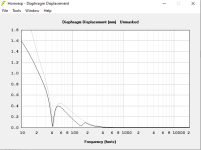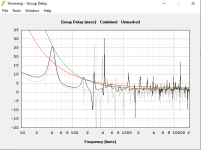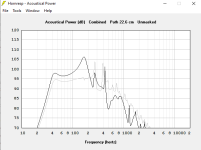I'm curious for your comments comparing the straight MLTL layout to tapered MLTL (ie POC#6)
Ie, what are pro/con of each and what has informed you to pursue a pair of tapered for next build?
The tapered TL will likely be a better match for a lower sensitivity but higher excursion driver, unless you plan to mount it magnet-out. The harmonics from the straight TL's vent are also going to be lower in frequency, which will reduce usable bandwidth. The larger vent of a straight TL does mean less power compression around Fb however. So the choice of which one is "best" could come down to what bandwidth you want to cover with the build, and how much power compression are you willing to accept as a result.
Last edited:
Do you already have the hornresp inputdata for it?
ID=BOXPLAN
Ang=2.0 x Pi
Eg=54
Rg=0.1
Fta=0
S1=750
S2=520
Par=47.1
F12=0
S2S=520
S3=288
Par=47.5
F23=0
S3S=288
S4=288
Par=50.8
F34=0
S4S=306
S5=306
Par=4
F45=0
Sd=533
Bl=21.67
Cms=0.000366
Rms=2.97
Mmd=80
Le=1.47
Re=6.7
OD=1
Vrc=0
Lrc=0
Ap1=0
Lp=0
Vtc=0
Atc=0
Pmax=800
Xmax=9.25
Path=22.6
Mass=0
Re'=5.72
Leb=0.74
Le=3.46
Ke=0.18
Rss=33.96
Rms=0
Ams=0
Comment=BOXPLAN-MLTL
POC7 (but I suspect that driver won't fit in the box)Ciare CSW7112EVO
POC3
Brian I posted the ciare drivers
Just for reference of 12" drivers with much more Xmax than the ones you used before.
Just for reference of 12" drivers with much more Xmax than the ones you used before.
Yup, I posted the corresponding Hornresp sims to show the "issue" with these and other high-Xmax drivers in the boxes in question. Vas for those drivers is a bit low (likely due to the heavier moving mass), which results in response curve that peaks at the resonance frequencies of the design.
0.63ft3 Sealed. It's basically a car door speaker or midbass driver that doesn't need a high pass filter.







The maximum size I can work with is 22" x 38" x 14.5", which basically limits me to 12" drivers.
This aspect ratio is almost a no go for dual/twin higher order design even 12". Going direct radiator is the best choice for dual driver.
Special design for Manifold using single 15" B&C 15TBX100 can fit the size constrain but:
Pros from Dual 12"
More SPL from 200L
Less dsp to achieve flat response
Can be used above 200Hz
Pros from Single 15"
Less diaphragm displacement for the same voltage, probably less distortion
Less power consumption witch result in longer play time considering energy supply from battery
Can achieve 200Hz
Leggend:
MLTL = Gray
Manifold = Black
Attachments
-
 Single 12 MLTL vs 15 Manifold 200L special - Displacement.png11.7 KB · Views: 55
Single 12 MLTL vs 15 Manifold 200L special - Displacement.png11.7 KB · Views: 55 -
 Single 12 MLTL vs 15 Manifold 200L special - GD.png16.5 KB · Views: 52
Single 12 MLTL vs 15 Manifold 200L special - GD.png16.5 KB · Views: 52 -
 Single 12 MLTL vs 15 Manifold 200L special - SPL.png13.4 KB · Views: 50
Single 12 MLTL vs 15 Manifold 200L special - SPL.png13.4 KB · Views: 50 -
 Dual 12 MLTL vs 15 Manifold 200L special - SPL.png13.5 KB · Views: 54
Dual 12 MLTL vs 15 Manifold 200L special - SPL.png13.5 KB · Views: 54 -
manifold15sp.txt2.7 KB · Views: 25
At $341.74 from Parts Express, the 15TBX100 is also 42% more expensive than two of the Dayton Odeum 12LF drivers ... 🙂
The 15TBX100 is also an 8 ohm driver, which will immediately halve the effective power that my car amp can deliver. 600W is still pretty decent though, and more than I'll likely ever supply to the subwoofer.
Finally, the two 12" MLTL boxes will be a lot easier to move around than one big box containing a 15" driver.
My main issue is possible power compression around Fb, seeing that the vent is 54% Sd. POC6's vent is 66% Sd, and I was measuring up to 2dB of power compression. I expect it would be slightly more with a vent that's 54% Sd. Whether it's audible is another matter, but I think that the big vents of MLTLs and THs and the corresponding reduced power compression effects is what makes these things sound quite different to a typical vented box.
The 15TBX100 is also an 8 ohm driver, which will immediately halve the effective power that my car amp can deliver. 600W is still pretty decent though, and more than I'll likely ever supply to the subwoofer.
Finally, the two 12" MLTL boxes will be a lot easier to move around than one big box containing a 15" driver.
My main issue is possible power compression around Fb, seeing that the vent is 54% Sd. POC6's vent is 66% Sd, and I was measuring up to 2dB of power compression. I expect it would be slightly more with a vent that's 54% Sd. Whether it's audible is another matter, but I think that the big vents of MLTLs and THs and the corresponding reduced power compression effects is what makes these things sound quite different to a typical vented box.
I had some time to do a bit of power-testing with POC7 loaded with the 3012LF. It got pretty loud for a 12" driver with 9mm Xmax, and power compression was pretty low, only around 0.7~0.8 dB around Fb. For the power tests, I was feeding it a sine sweep with a LP filter 100 Hz LR 24dB/octave and a HP filter 35 Hz Butterworth 36dB/octave, which kept excursion and distortion below Fb at safe limits at high power levels. I also used a little DSP to pull up the response a bit around 80 Hz. The POC7 sounded clean all the way up to the point that the 3012LF was hitting its limits.
The THD profile is interesting. It doesn't look anything like what I'd expect from a vented alignment. There's no noticeable dip around Fb. If anything, odd order distortion is higher at Fb, which is unusual, but it's still pretty low. My garage roof was rattling along with my windows at its peak SPL levels. I think two smaller MLTLs that use 12" drivers with 9mm Xmax tuned to a little higher (~42 Hz) will be more than enough for my needs.


What I need now is to find a suitable amplifier to run the whole rig. Something like 100Wx4 into 8 ohms, bridgeable for 2.1 use, and built-in DSP (or at least HP and LP filters and a HP "protection" filter for the subwoofer.
The THD profile is interesting. It doesn't look anything like what I'd expect from a vented alignment. There's no noticeable dip around Fb. If anything, odd order distortion is higher at Fb, which is unusual, but it's still pretty low. My garage roof was rattling along with my windows at its peak SPL levels. I think two smaller MLTLs that use 12" drivers with 9mm Xmax tuned to a little higher (~42 Hz) will be more than enough for my needs.
What I need now is to find a suitable amplifier to run the whole rig. Something like 100Wx4 into 8 ohms, bridgeable for 2.1 use, and built-in DSP (or at least HP and LP filters and a HP "protection" filter for the subwoofer.
Last edited:
THANK YOU!!! I knew something had to be wrong for all the different models to come out crazy.(Your qms (and rms) are messed up in the sim )?
- Home
- Loudspeakers
- Subwoofers
- Big, big TL...